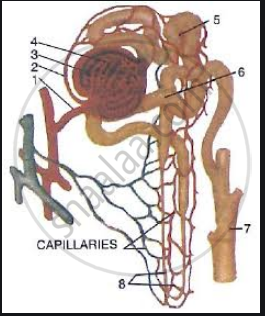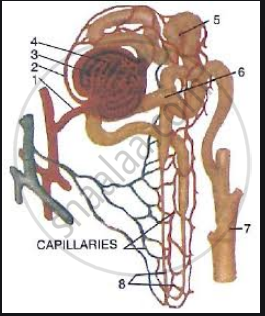Advertisements
Advertisements
Question
Explain the difference between the excretory system of humans and plants.
Solution
| Excretory system in humans | Excretory system in plants |
| Humans have a well-developed excretory system for the elimination of nitrogenous wastes. | Plants do not have a well-developed excretory system for the elimination of nitrogenous wastes. |
| The human excretory system comprises the kidneys, blood vessels that join them, ureters, urinary bladder, and urethra. | Plants use different strategies for excretion. |
| Excretion is in the form of urine produced to filter out the waste products, like urea and uric acid, from the blood. | Excretion is by means of tannins, gums, essential oils, etc stored in special cells. |
APPEARS IN
RELATED QUESTIONS
What are the methods used by plants to get rid of excretory products?
_____________ secreted by the (ii) _____________ lobe of the pituitary gland. If this hormone secretion is reduced, there is an increased production of urine. This disorder is called (iii) ____________. Sometimes excess glucose is passed with urine due to hyposecretion of another hormone called (iv) _____________ leading to the cause of a disease called (v) ______________.
Explain Selective reabsorption
Write the functions of Kidney
Correct the following statements by changing the underlined words:
The normal pale yellow colour of the urine is due to the presence of the pigment Melanin.
What is the role of glomerulus in the kidney?
What are the methods used by plants to get rid of their waste products?
If a patient is out on dialysis, he is most likely suffering from a severe ailment of the:
(a) circulatory system
(b) respiratory system
(c) excretory system
(d) digestive system
Why is excretion necessary in living beings?
Tick the most appropriate answer.
The process of removing waste from the body is called
Look at the figure given bellow, it is a section of human kidney as seen from the front.

Is it a longitudinal section or a cross-section?
The following diagram represents a mammalian kidney tubule (nephron) and its blood supply.

Parts indicated by the guidelines 1to 8 are as follows:
1. Afferent arteriole from renal artery
2. Efferent arteriole
3. Bowman's capsule
4. Glomerulus
5. Proximal convoluted tubule with blood capillaries
6. Distal convoluted tubule with blood capillaries
7. Collecting tubule
8. U-shaped loop of Henle
Study the diagram and answer the question that follow:
Which structure (normally) contains the lowest concentration of glucose?
The following diagram represents a mammalian kidney tubule (nephron) and its blood supply.

Parts indicated by the guidelines 1to 8 are as follows:
1. Afferent arteriole from renal artery
2. Efferent arteriole
3. Bowman's capsule
4. Glomerulus
5. Proximal convoluted tubule with blood capillaries
6. Distal convoluted tubule with blood capillaries
7. Collecting tubule
8. U-shaped loop of Henle
Study the diagram and answer the question that follow:
Where is most water reabsorbed ?
Name the Following
The branch of renal artery which enters into Bowman’s capsule.
Complete the following sentence with appropriate words:
The outer surface of the kidney is ______ while the inner surface is ______.
When uric acid is produced in excess, it gets deposited in joints, resulting in ____________.
The process of diffusion of solvent particles from the region of less solute concentration to a region of high solute concentration through a semi-permeable membrane is known as ____________.
In a person the tubule part of the nephron is not functioning at all. What will its effect be on urine formation?
Name the following;
Three nitrogenous wastes of our body.
